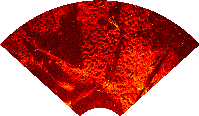 Sector Scan Images
Sector Scan Images
In a working diver-held system, the beams will be formed simultaneously, rather than by scanning a single element. Fewer beams and a slower sampling rate means a faster, cheaper, and smaller system. However, fewer beams means reduced resolution in azimuth and a slower sampling rate means reduced resolution in range.
The resolution of the test sonar system is 0.09 degrees in azimuth by 0.5 cm in range. By ignoring data appropriately, we can simulate the images which would be obtained using a system with less resolution. These images explore the effects of reduced resolution in both range and azimuth. Note that the resolution of these pictures is less than 0.5 cm in range due to the limited number of pixels available.
The smoothed images were created by linear interpolation in azimuth. The images were not smoothed in range. The non-smoothed images (and all images in range) were created using pixel replication.
kfink@scn.org